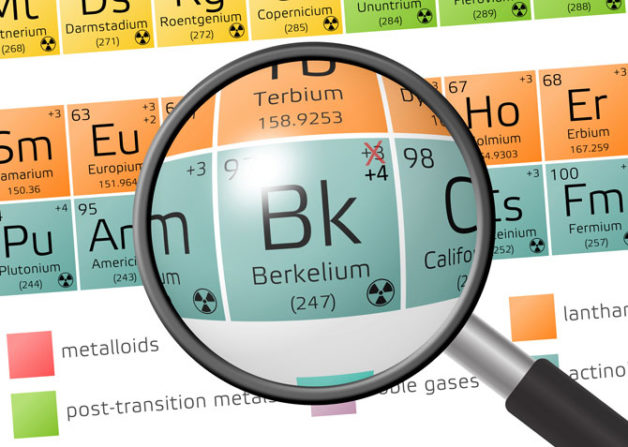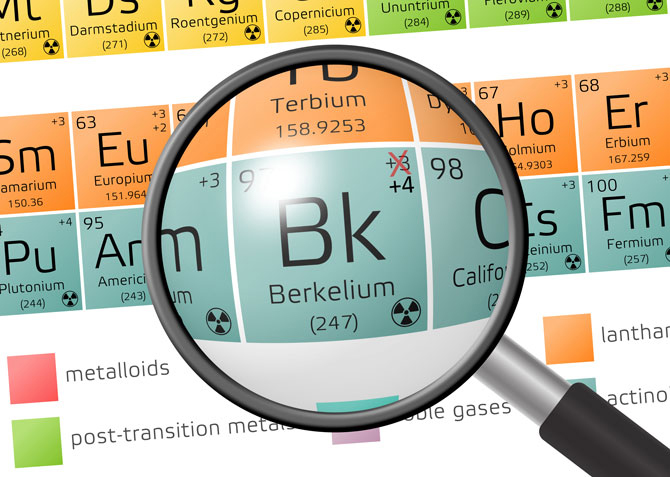Berkeley, California, has a reputation for doing things differently, so it seems fitting that the element named after this city would stand out among its peers in some unusual way.

Berkeley Lab scientists discovered that the radioactive element berkelium has four positive charges in its oxidized state, unlike most of the other elements in its class. (Credit: iStock)
Using several spectroscopic techniques, scientists at the Department of Energy’s Lawrence Berkeley National Laboratory (Berkeley Lab) found that the element berkelium breaks form with its heavy element peers by taking on an extra positive charge when bound to a synthetic organic molecule. This property could help scientists develop better methods for handling and purifying nuclear materials.
The discovery, led by scientist Rebecca Abergel at Berkeley Lab’s Chemical Sciences Division, appears April 10 in the journal Nature Chemistry.
“Berkelium is one of the highly radioactive elements present in nuclear waste, so we need to understand how to store it as well as separate it from other elements that are more useful for creating energy,” said Abergel. “We discovered that berkelium behaves very differently from its neighboring elements. It’s an outlier, and that characteristic could be used to distinguish it from other actinides.”
Berkelium is one of 15 actinides, elements with atomic numbers 89 to 103. Because these rare, heavy metal isotopes are radioactive, they are difficult to study. Abergel leads one of the few research groups in the world studying berkelium, using a rare, minute sample produced at DOE’s Oak Ridge National Laboratory. (Click here to read more about ORNL’s role in this paper.)
The heaviest actinide elements react in their environment to form stable species, mostly trivalent species, because they lose three electrons in the process. It had been theorized that berkelium, unlike the other elements beyond plutonium, could exhibit stabilized oxidation states with both three and four positive charges.
To test this theory, the researchers used a synthetic version of siderophores, molecules used by microorganisms to transport metal ions. This ligand was made to sequester the actinide ions and form soluble complexes.
“We forced berkelium into a different electron configuration by using this class of compounds,” said Abergel. “Berkelium stood out from other heavy actinide elements, which stayed in their trivalent form. It’s a difference that could be used to separate it from other nuclear materials.”
“The experimental results were hinting at this unusual behavior in berkelium, but there wasn’t enough experimental evidence to say yes, 100 percent, this is what we’re seeing,” said study co-author Wibe Albert de Jong, senior scientist and group leader of Berkeley Lab’s Computational Chemistry, Materials and Climate Group. “To be 100 percent sure, we did large computational simulations and compared them to the experimental data and determined that they were, indeed, seeing berkelium in an unusual oxidation state.”
The computational simulations utilized novel methods developed through a DOE Scientific Discovery through Advanced Computing (SciDAC) project focused on advancing software and algorithms for photochemical reactions. De Jong is part of the project.
The researchers were able to provide even more confirmation utilizing x-ray crystallography at Berkeley Lab’s Advanced Light Source, a DOE Office of Science User Facility.
“Until recently, there was little to no structural data on berkelium or californium,” said Abergel. “This allows us to get a great deal of data out of much smaller crystals. It’s not only safer, but more efficient for these rare and radioactive materials.”
The work was supported by DOE’s Office of Science.
###
Lawrence Berkeley National Laboratory addresses the world’s most urgent scientific challenges by advancing sustainable energy, protecting human health, creating new materials, and revealing the origin and fate of the universe. Founded in 1931, Berkeley Lab’s scientific expertise has been recognized with 13 Nobel Prizes. The University of California manages Berkeley Lab for the U.S. Department of Energy’s Office of Science. For more, visit www.lbl.gov.
DOE’s Office of Science is the single largest supporter of basic research in the physical sciences in the United States, and is working to address some of the most pressing challenges of our time. For more information, please visit science.energy.gov.
